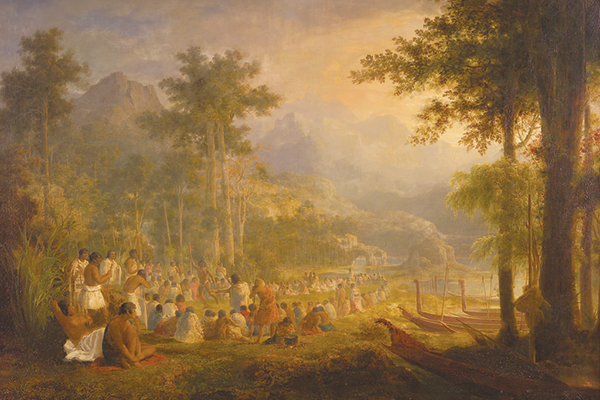In a world where everyone knows the names Leonardo da Vinci, Vincent Van Gogh and Pablo Picasso, it’s easy to assume that all art of value comes from overseas. In actual fact, the art history of New Zealand is arguably just as rich, inspiring, and fascinating as that of Europe. And better yet—it’s right on our doorstep. The latest exhibition at the Hocken Collections summarises and celebrates the short yet stunning history of art in New Zealand.
Highlights at the Hocken: Documenting the History of New Zealand Art, begins with works from the time of European settlement in New Zealand. 'The New Zealand Chiefs in Wesley’s House' is an enormous and slightly intimidating painting, depicting Maori/Pakeha relations from 1863. In a similar vein, John Alexander Gilfillan’s “A Native Council of War” from 1853 sheds a hazy, romantic light over a scene in which Maori people gather to discuss upcoming conflict. Although these paintings are aesthetically gorgeous and skilfully rendered, more than anything they seem to hark back to a disturbing period in New Zealand history, captured through conservative and essentially racist eyes.
The exhibition does not dwell here, however. Photography rapidly propels you into the twentieth century, with works such as “Dunedin City Council Electricity Department, Cumberland Street” by Franz Barta providing a familiar snapshot into 70’s life in Dunners. Shigeyuki Kihara, a fantastic Samoan/New Zealand photographer, also features here; her piece “Ulugali’i Samoa; Samoan Couple” from 2005 adds a sense of multiculturalism and assertion of new identities in the art world.
But for me the big names which I was most excited to see were those of Ralph Hotere and Colin McCahon—two of my personal fave kiwi artists, who never fail to surprise and enchant with their unique and captivating respective styles.
'Black Painting XII From 'Malady', a Poem by Bill Manhire' (1970) by Hotere is both beautiful and dark, figuratively and literally. The 'Malady' series to which this work belongs explores the similarities of the words ‘melody’, ‘malady’ and ‘my lady’, phrases with starkly differing connotations but close proximity in sound. These works seem to suggest the correlation between harmony, sickness, and human relationships, and the fragility of these words against a void-like, black background.
'John in Canterbury' (1959) by McCahon is strongly abstract and expressionist in style, composed with earthy tones of yellows and black. The strangely beautiful, scrawled line of poetry (“God, it is all dark. The heart beat but there is no answering hark of a hearer and no one to speak”) is taken from the New Zealand writer John Caselberg. There’s something about the textual paintings of McCahon which are simultaneously stirring and poignant, and seem to allude to much bigger truths than a canvas alone could contain.
If you’re interested in the history or art history of Aotearoa, absolutely head along to this stunning showcase exhibition. If you like it that much there’s also a catalogue available to purchase, the money supporting the absolute treasure trove that is the Hocken Collections.



